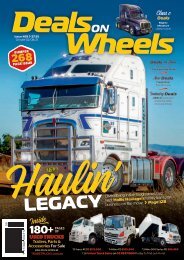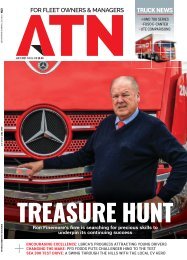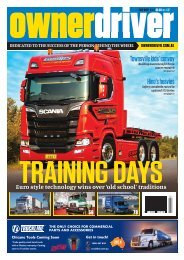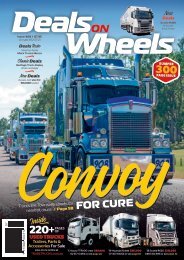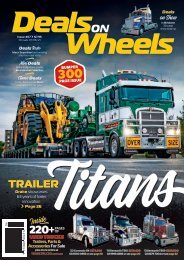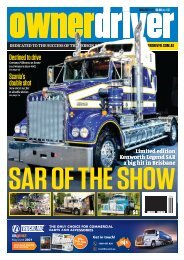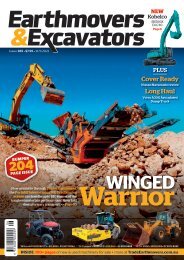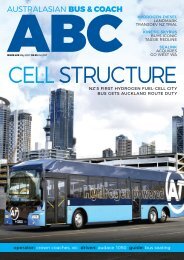Deals On Wheels #454
Create successful ePaper yourself
Turn your PDF publications into a flip-book with our unique Google optimized e-Paper software.
Anything fingers are<br />
needed for are close at<br />
hand on the bent dash.<br />
The driver is faced<br />
with two screens – one<br />
for instrumentation<br />
and a touch screen on<br />
the left that controls<br />
the vehicles various<br />
information media<br />
Predictive powertrain<br />
control taps into<br />
topographical<br />
information to inform<br />
the truck of the best<br />
point to make or not<br />
make a gear shift<br />
control unit taps into topographical<br />
information, including pre-mapped threedimensional<br />
GPS data. Mercedes-Benz says<br />
Australia’s A and B roads and many more<br />
are already in the system and the truck<br />
additionally learns the routes it travels on.<br />
This data is then used to inform the truck<br />
of the best point to make a shift or, in many<br />
cases, to not shift and hang on to a gear just<br />
a little longer in order to crest a hill. PPC can<br />
be used in conjunction with cruise control at<br />
speeds between 25km/h and 100km/h.<br />
The new Actros retains its adaptive cruise<br />
control function that can modulate the speed<br />
of the truck in heavy traffic, even when the<br />
traffic grinds to a halt.<br />
ON THE SAFE SIDE<br />
It also sees the introduction of the latest<br />
generation of standard safety technology<br />
with ‘Active Brake Assist 5’.<br />
This system uses a radar and camera that<br />
work together to try and prevent avoidable<br />
collisions.<br />
The news with ABA 5 is that it can now<br />
bring the truck to a complete halt when<br />
it detects moving pedestrians. It can also<br />
stop completely for moving or stationary<br />
vehicles when the driver may be distracted,<br />
something that is proven to save lives and<br />
reduce road trauma.<br />
Given the title ‘Autonomous Emergency<br />
Braking’ (AEB) by safety authorities, this<br />
technology is the easiest way to avoid or<br />
reduce the impact of collisions including<br />
heavy vehicles.<br />
While you can’t put a price on a human life,<br />
or reducing road trauma, you can put a price<br />
on crash repairs.<br />
Importantly, for those bean counters, AEB<br />
technology has also seen repair costs for<br />
frontal damage to trucks drop remarkably.<br />
Last year, a massive fleet based in Salt Lake<br />
City, Utah, had a graph representing crash<br />
costs over the past few years. Benz insiders<br />
insist the drop when AEB was introduced<br />
across the fleet was striking. “It was less of a<br />
drop and more of a plummet,” they say.<br />
VISION THING<br />
While it is undeniable that AEB is a crucial<br />
element for modern fleets, the new<br />
‘MirrorCam’ system does not have such<br />
universal acceptance at this stage.<br />
Mercedes-Benz has decided to make it an<br />
option rather than standard. Why? It has been<br />
a big hit in Europe so far after all.<br />
Some drivers in the local validation fleet<br />
disliked the slightly convex vision displayed<br />
on the screens when reversing into a loading<br />
bay. Other test drivers got used to them<br />
straight away and wouldn’t ever go back to<br />
traditional mirrors.<br />
Mercedes-Benz listened and decided to take<br />
the horses-for-courses approach; the customer<br />
can decide which horse they’d like to ride.<br />
162




